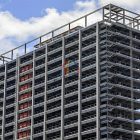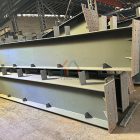Description of failure modes of high-rise steel structures
Due to the large volume, wide area and large flow of people in large high-rise buildings, once the building collapses, the consequences are unimaginable. Therefore, for high-rise buildings, their seismic performance is far better than that of ordinary buildings. The structure is considered to have excellent seismic resistance. In severe earthquakes, the seismic damage of high-rise steel structures is less than that of steel-concrete structures, and overall damage and collapse are rarely caused.
However, because the research on high rise steel structure is still in its infancy, and the seismic damage form of high-rise steel structure is completely different from traditional buildings. Therefore, the research on the seismic damage form of high-rise steel junctions has become one of the key points. The four failure modes of high rise steel structures are described below.

1. Structural collapse
Structural collapse is the most serious form of structural damage in earthquakes. This form of failure usually occurs when the structural stress is concentrated in the weak layer of the structure, causing part of the structure to be destroyed, resulting in a chain reaction, which eventually leads to the instability of the overall structure. This requires the designer to uniformly design the strength of the high rise steel structure in the design process to avoid the generation of weak structural layers.
2. Node destruction
Node failure is the most frequent form of failure in earthquakes. This form usually occurs when the stress is concentrated on a node with construction defects or design problems, or when a node is stressed unevenly, so that the node is easily damaged in an earthquake. The main manifestations are: riveting fracture, dislocation of welding parts, bending of stiffeners, fracture and bending of webs, etc.
3. Component damage
The main forms of component failure are support failure and beam-column failure. When the earthquake intensity is large, the support bears the axial force of repeated tension and compression. Once the stress exceeds the buckling critical force of the brace, failure or buckling occurs. For push-beam columns, there are mainly buckling of wing elephants, tearing of wing gaps, and even horizontal cracks or fractures in frame columns. For frame beams, there are mainly failure modes such as flange buckling, web bending and cracking, and torsional bending.

4. Foundation anchor failure
The failure of foundation anchorage is mainly related to structural design, structural structure, construction quality, material quality, and daily maintenance. If the building construction process is improper, there will be gaps or illegal operations. In this way, although the appearance of the completed building cannot be seen, once an earthquake occurs, the anchor bolts at the column foot will be disengaged, the concrete will be anchored by the slam-derivative failure, and the connecting plate will be broken. This requires that the seismic design of high-rise steel structures must strictly follow the relevant regulations.












